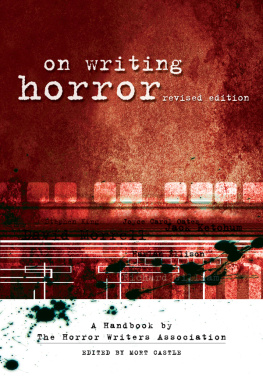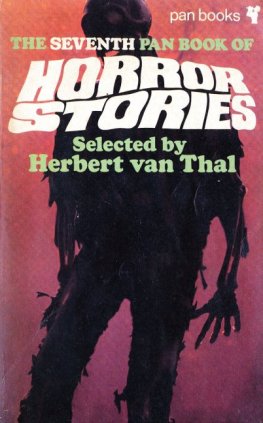Permissions
Foreword: The Horror Writers Association: A Shockingly
Brief and Informal History of the HWA, 1996, 2005 by ShadoWind, Inc.
Editors Introduction 2005 by Mort Castle.
The Madness of Art 1994, 1996, and 2005 by Joyce Carol Oates.
Acceptance Speech: The 2003 National Book Award for Distinguished Contribution to American Letters 2003 by Stephen King and the National Book Foundation.
Why We Write Horror 2005 by Michael McCarty.
What You Are Meant to Know 1996, 2005 by Robert Weinberg.
Avoiding Whats Been Done to Death 1987, 2005 by Ramsey Campbell.
Workshops of Horror (and Seminars and Conferences) 2005 by Tom Monteleone.
Degrees of Dread 2005 by Michael A. Arnzen.
A World of Dark and Disturbing Ideas 1996, 2005. by J.N. Williamson
Mirror, Mirror 1996, 2005 by Wayne Allen Sallee.
Going There 2005 by Michael Marano.
Honest Lies and Darker Truths 1996, 2005 by Richard Gilliam.
Such Horrible People 1996, 2005 by Tina Jens.
A Hand on the Shoulder 1996, 2005 by Joe R. Lansdale.
Eerie Events and Horrible Happenings 2005 by Nicholas Kaufmann.
Reality and the Waking Nightmare 1987, 2000, 2002, 2005 by Mort Castle.
He Said? She Asked 1996, 2005 by David Morrell.
Keep It Moving, Maniacs 1996, 2005 by Jay R. Bonansinga.
The Dark Enchantment of Style 2005 by Bruce Holland Rogers.
Innovation in Horror 1996, 2005 by Jeanne Cavelos.
Depth of Field 2005 by Nick Mamatas.
Splat Goes the Hero 1996, 2005 by Jack Ketchum.
Darkness Absolute 1987, 2005 by Douglas E. Winter.
On Horror: A Conversation With Harlan Ellisonand Richard Gilliam 1996, 2005 by The Kilimajaro Corporation.
Acts of Madness 2005 by Lisa Morton.
Fear Spins Off 2005 by Yvonne Navarro.
The Plays the Thing on the Doorstep 2005 by Richard E. Dansky.
Now Fear This 2005 by Scott Hickey and Robert Madia.
Good Characters and Cool Kills 2005 by Brendan Deneen.
Dark Fluidity 2005 by Judi Rohrig.
The Small Press 2005 by John Everson.
Sharing the Creeps 1996, 2005 by Edo van Belkom.
For Love or Money 2005 by Bev Vincent.
One Reader at a Time 2005 by Scott Nicholson.
Afterword: Quiet Lies the Locust Tells by Harlan Ellison originally appeared in Stalking the Nightmare, copyright 1982 by The Kilimanjaro Corporation. Reprinted by arrangement with and permission of, the author and the authors agent, Richard Curtis Associates, Inc. New York. All rights reserved.
No More Silver Mirrors 1996, 2005 by Karen E. Taylor.
Fresh Blood From Old Wounds 2005 by Joseph Curtin.
More Simply Human 1996, 2005 by Tracy Knight.
The Possibility of the Impossible 2005 by Tom Piccirilli.
Take a Scalpel to Those Tropes 2005 by W.D. Gagliani.
That Spectred Isle 2005 by Steven Savile.
New Horrors: A Roundtable Discussion 2005by Joe Nassise.
Archetypes and Fearful Allure 1996, 2005 by Nancy Kilpatrick.
Writing for the New Pulps 1996, 2005 by John Maclay.
Freaks and Fiddles, Banjos and Beasts 2005 by Weston Ochse.
Youth Gone Wild 2005 by Lee Thomas.
Writing Horror Comic Books And Graphic Novels 2005 by David Campiti.
Acknowledgments
Many, many thanks to all who contributed to On Writing Horror, but super special oh yeah many thanks to the trademarked Harlan Ellison, who is the benchmark for quality, integrity, and intelligence; and to Bob Weinberg, who might not know everything about horrorbut then again, he just might.
This book is dedicated to J.N. Williamson, aka Avuncular Jer, aka Big Guy, aka The Hoosier Sage of Horror, aka my friend, my teacher .
We miss you, Big Brother, and we remember and honor you.
MORT CASTLE
May 2006
About HWA
The Horror Writers Association is a worldwide organization of writers and publishing professionals dedicated to promoting the horror genre. Formed in the late 1980s, it is the oldest and most respected organization celebrating the writers who revel in bringing sleepless nights to readers. Find out more at www.horror.org
Foreword: The Horror Writers
Association: A Shockingly
Brief and Informal History
of the HWA
Stanley Wiater
As with most great ideas, the concept for a horror writers association originated in the fevered imagination of one individualin this instance, one Robert R. McCammon. In an interview with Publishers Weekly in 1984, the author (who had already published six horror novels) first publicly expressed his desire for a professional organization specifically geared to the needs of fellow writers of fear. At that point, however, his decidedly colorful name for the then-nonexistent organization was HOWL, Horror and Occult Writers League. Even so, reasoned McCammon, mystery writers had their professional organizations, as did science fiction writers. Wasnt it past time that the equally honorable genre of terror, fright, and the supernatural be formally recognized?
Perhaps more than anyone, McCammon was shocked at the subsequentand often sincereinterest of the media in his remarks, including The New York Times and The Washington Post. Then the B. Dalton and Waldenbooks chains wanted to know more. Horror writers began to hear the HOWL and wrote McCammon to ask where to sign up, although it had always been his intent to survey every writer he could contact first before ever making a formal announcement about the proposed organization. Nevertheless, McCammon was deluged with still more letters of support from writers, editors, and scholarsboth stateside and overseasmy own enthusiastic response as a self-styled horror journalist included.
Before long, McCammon enlisted the support of two colleagues who were instrumental in bringing the concept of HOWL snarling into reality: Texas author Joe R. Lansdale and his wife, Karen. They, in turn, sent out a formal letter of invitation to some 177 writers, 88 of which responded with suggestions or a willingness to join.
Working by phone and letter with McCammon, the trio committed themselves to the insane task of creating what they believed could be a nationally, perhaps even internationally, recognized writers organization. Thanks primarily to Karens unflagging energy, they then drew up the constitution and bylaws, formulated mailing lists, ran ads, issued press releaseswhatever it took to ensure that, from the outset, HOWL would be recognized as a professional writers organization, not a fan club for sideshow horror buffs.
Other new volunteers contributed in numerous ways, most notably in the production and content of the early newsletters. We took our organization seriously right from the bloody start. Why not? Stephen King and Peter Straub, among others, were becoming increasingly known as brand-name writers. For the first time, horror was being labeled as a separate category in most bookstores. The entire field was riding a growing wave of popularity in the 1980s; it was only logical that those of us exploring this increasingly recognized genre would desire to have our own legitimate organization.















